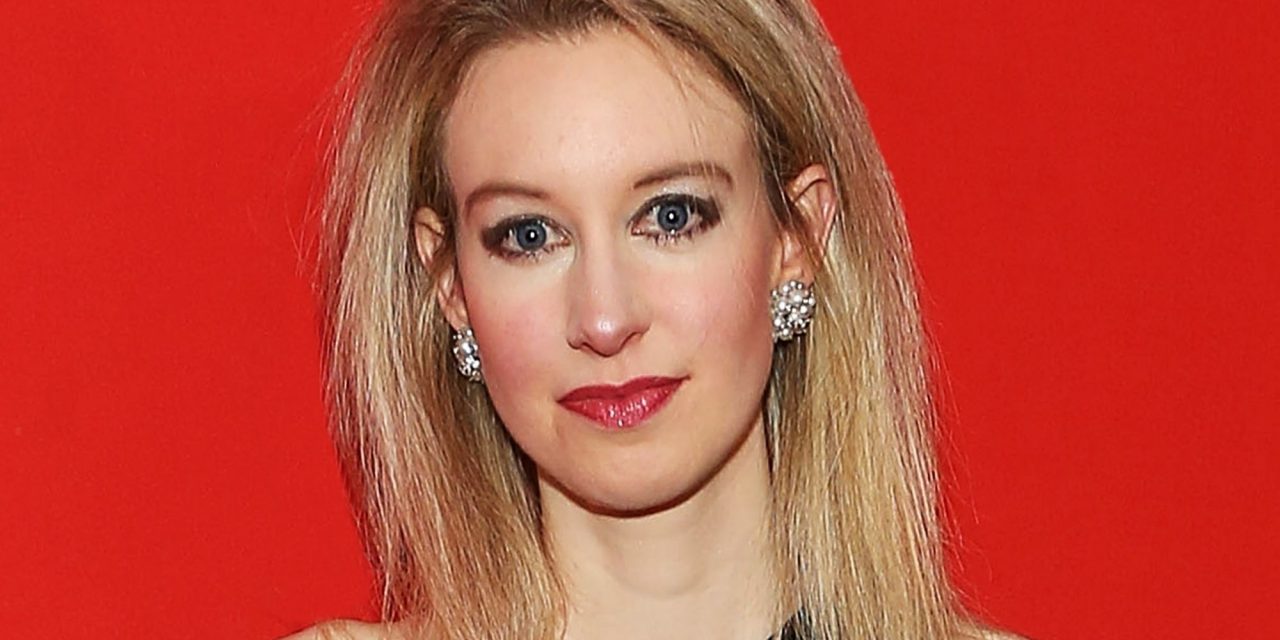
Though the biggest scandal on people’s radar these days is Fyre Festival, there’s another one that’s been brewing in the public’s consciousness: Theranos.
The story of the once famed biotech startup, founded by Stanford dropout Elizabeth Holmes, eerily echoes the quicksand-like trajectory of Billy McFarland’s doomed festival. And it’s the subject of a recently premiered HBO documentary by Alex Gibney, called The Inventor: Out For Blood In Silicon Valley.
Worth over $9 billion at its zenith, blood-testing startup Theranos imploded after a watershed moment in which The Wall Street Journal ’s John Carreyrou broke the yet unknown story of its fraud to the public.
Theranos eventually dissolved in September 2018, and many are now wondering: What the hell happened? Ahead, we dive into the story, breaking down step by step how Holmes went from promising young bio-genius to disgraced liar, bringing Theranos down with her. If you are not yet familiar with Elizabeth Holmes or Theranos, then buckle up — it’s a wild ride.
2003: Theranos is founded
Elizabeth Holmes starts Theranos — a word that combines “therapy” and “diagnosis” — when she is just 19. Her idea is to revolutionize healthcare by making blood-testing procedures cheaper and more convenient. She drops out of Stanford the next year and begins building the company through the sales pitch that it could detect health problems with just a few drops of blood from a finger prick. From the onset, Holmes was able to secure high-profile investors including Henry Kissinger, Betsy DeVos, and Rupert Murdoch.
2004: Theranos raises $6.9 million
With this early funding, the company gains a $30 million valuation.
2007: Company valuation hits nearly $200 million
After three years of early-round fundraising, Theranos receives a company valuation of $197 million.
2010: Theranos raises $45 million
Theranos files a U.S. Securities and Exchange Commission form that states it has raised $45 million by selling equity, options, warrants, and other security rights. At this point, Theranos is valued at $1 billion.
2013: Theranos announces itself to the public
Having kept a low profile during its first years in order to focus on research and fundraising, Theranos unveils a website and introduces its product to the world through press releases and media features.
September 2013: Theranos announces Walgreens partnership
The deal with Walgreens commercializes Theranos’s tests and opens them up to the public. Prior to this, Theranos had been a research-and-development operation. After commercializing its tests in Walgreens, Theranos begins reaching consumers directly.
2014: Theranos value exceeds $9 billion
Theranos and its founder, Holmes, are regularly featured across high-profile media platforms, with stories in The New Yorker, Forbes, and more. However, there is rising scrutiny of Holmes’s technology, and her profile in The New Yorker calls her explanations of the procedure “comically vague.”
Fortune announces that the company has raised $400 million in equity sales and is valued at over $9 billion. Thanks to her 50% stake, Holmes is now a multi-billionaire.
2015: Theranos is criticized by some in the medical community
A piece in The Journal of the American Medical Association, penned by John P.A. Ioannidis, MD, DSc, criticizes Theranos for having operated in “stealth mode” for years without publishing research in peer-reviewed medical journals.
The same year, Capital BlueCross, central Pennsylvania’s largest health insurer with over 700,000 consumers, selects Theranos as its lab and bloodwork provider. At this time, the company reaches a $10 billion valuation.
July 2015: Theranos test approved by the FDA
Theranos’s test for detecting herpes simplex virus 1 is approved by the Federal Drug Administration (FDA). But by December, the test has come under scrutiny. This is the only Theranos test to be approved by the FDA.
October 15 & 16, 2015: The WSJ publishes a damning report on Theranos
Things take a turn for Theranos after The Wall Street Journal publishes John Carreyrou’s in-depth exposé on the company. In the piece, Carreyrou interviews ex-employees who claim management is incompetent, has exaggerated the capability of the technology, and is deceiving the public.
Later that day, Holmes appears on Mad Money in an attempt to do damage control in the face of rampant accusations. She claims the statements in the WSJ are false, that Theranos had supplied over 1,000 pages of documentation that disprove the allegations, and that she is disappointed to see that the piece has been published. Holmes says: “This is what happens when you work to change things. First, they think you’re crazy, then they fight you, and then all of a sudden you change the world.”
On October 16, one day after its initial bombshell, the WSJ releases a follow-up piece that reports Theranos has been forced to cease use of its unapproved nanotainer for all of its blood tests, except for one. The Wall Street Journal also stands by its reporting.
October 27, 2015: The FDA releases a report from its Theranos investigation
The FDA releases a partly redacted report from an ongoing investigation of Theranos equipment. Among other things, the report claims that Theranos had used an “uncleared medical device” whose design was “not validated under actual or simulated use conditions.”
November 2015: Potential Theranos-Safeway deal folds
A $350 million deal with Safeway falls through, as reported by the WSJ. The partnership would have allowed Theranos to offer tests in more than 800 supermarkets. Though Safeway has spent money to build the clinics, the tests never begin.
December 2015: The WSJ publishes another article on Theranos
Carreyrou reports that Theranos has rigged tests to produce better results. The article also alleges company mismanagement.
January 25, 2016: Theranos lab in Newark, CA, is found to be a threat to patient health
The Centers for Medicare and Medicaid Services (CMS) pens a letter to Theranos after an inspection of its Newark, California, lab. The investigation, which took place in the fall of 2015, had found that the facility did not “comply with certificate requirements and performance standards” and caused “immediate jeopardy to patient health and safety.”
Theranos soon responds, claiming that the investigation had begun “months ago” and “does not reflect the current state of the lab.”
January 28, 2016: Walgreens suspends tests at its Theranos Wellness Center
In light of the CMS report, Walgreens announces it will stop tests at its Theranos Wellness Center inside of its Palo Alto store, also suspending its use of Theranos’s lab in Newark “until all issues raised by CMS have been fully resolved.”
April 2017: Theranos settles with CMS
In a settlement with CMS, Theranos agrees to stay out of the blood-testing business for two years in exchange for reduced penalties from federal health authorities. The civil monetary penalty against the company is only $30,000, says Theranos.
May 2017: Theranos settles with one of its largest investors
The settlement with Partner Fund Management (PFM), one of the company’s largest investors, comes after PFM accuses them of securities fraud.
March 2018: Theranos charged with massive fraud
The U.S. Securities and Exchange Commission (SEC) charges Holmes and former Theranos president Ramesh “Sunny” Balwani, accusing them of “raising more than $700 million from investors through an elaborate, years-long fraud in which they exaggerated or made false statements about the company’s technology, business, and financial performance.”
In the wake of this charge, Holmes is stripped of her control of the company, forced to return millions of shares to Theranos, and is barred from serving as an officer or director of any public company for ten years.
June 2018: Holmes and Balwani indicted on eleven counts of fraud and conspiracy
A federal grand jury indicts both Holmes and Balwani on two counts of conspiracy and nine counts of wire fraud, finding that the pair had “engaged in a multi-million dollar scheme to defraud investors, and a separate scheme to defraud doctors and patients.”
In the wake of the indictment, Holmes steps down as CEO, but remains on the company’s board.
September 5, 2018: Theranos shutters
Unable to find a buyer, Theranos is forced to close, announcing it will pay its creditors with its remaining cash. The company announces its closing in an email to investors. Its remaining employees were laid off at the close of August, though CEO David Taylor and some support staff had remained on the payroll a few days longer. At this time, the Theranos website is shut down, and the WSJ reports that any equity investments in the company are worthless.
Like what you see? How about some more R29 goodness, right here?
A Week In Austin, TX, On A $99,000 Joint Salary
Here's What Lunar New Year Red Envelopes Are All About
It's Expensive To Be On The Bachelor, But Contestants Make It All Back On Instagram
Read more: refinery29.com






Recent Comments